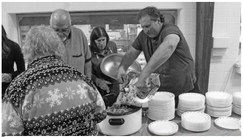A COVID-19 lesson
Perhaps Mr. Purdue spoke too soon. During an April 15 press conference at the White House, U.S. Secretary of Agriculture “Sonny” Perdue sought to reassure Americans rattled by the COVID-19 pandemic that, yes, there was plenty to worry about, but food was not one of those things.
He said the following: For Americans who may be worried about access to good food because of this, I want to assure you the American food supply is strong, resilient and safe….Our supply chain is sophisticated, efficient, integrated and synchronized, and it’s taken us a few days to relocate the misalignment between institutional settings and grocery settings, but that does not mean that we don’t have enough food in this country to feed the American people. You might think of it as an interstate when it’s little flowing along well, and you have a crash at one place. It backs up, and that’s what’s happening in the food supply chain, but we’re working through that.
That was three weeks ago. In recent days, however, we’ve seen large beef, pork and chicken slaughterhouses shut down after hundreds of workers have fallen ill due to the coronavirus. The disruptions have brought on spot shortages of meat. Over 1,000 Wendy’s fast-food restaurants don’t have any hamburgers to fry. Kroger, the nation;s largest supermarket chain, has capped purchases of meat products. Ditto at Costco, a large discount retailer.
On April 28, President Donald Trump, faced with the closing of 20 slaughterhouses run by food business giants Smithfield Food, Cargill and Tyson, invoked the federal Defense Production Act, ordering these processing plants to stay open. The act puts meat processing workers back on assembly lines stripped of their right to sue their employer should they get sick with coronavirus.
As meat counter shelves go bare in some supermarkets, farmers don’t know what to do with all of their hogs, beef cattle and chickens. The beef industry is circulating a plan where the federal government would pay $2.90 a head to put an estimated 600,000 cattle, ready for slaughter, on a maintenance diet for 75 days.
There is an obvious question in all of this. Is our food system, as praised by Mr. Perdue, truly sophisticated, efficient, resilient and safe? Or, maybe, is it just too big and consolidated?
The current pandemic is a true stress test for our food supply chain. The test is not over, but, as of today, the system appears shaky, insecure.
Four companies control 60 percent of the American chicken market. Four companies control 85 percent of beef processing. And four companies are in charge of 52 percent of pork production. This is a highly concentrated sector of the economy. But maybe it shouldn’t be. Maybe we should have more, smaller food processing plants across the nation.
For years, farmers have railed against consolidation in the food processing business. Fewer buyers of commodities has meant less competition and lower prices. Now, consumers are understanding, too, the perils of having too few players in the food business. A nation stuffed full of food to eat may not make it to the dinner table if there is a processing bottleneck. And that can happen during a pandemic.
The truth be told, the American food system is a marvel. Meat, vegetables and fish from around the planet are sold in U.S. grocery stores located in even the most rural, out of the way places. The logistics of food distribution are mind-boggling. And, by and large, food is affordable in this country, even cheap.
But sometimes bigger is not always better. The COVID-19 pandemic is teaching us that further consolidation of the food system will not make our food supply chain more resilient. Just the opposite.

